This is my summary of the OVERSIGHT HEARING on The Preventable Epidemic: Youth Suicides
and the Urgent Need for Mental Health Care Resources in Indian Country held Thursday,
March 25, 2010. WEBCAST here. [172 mins.]
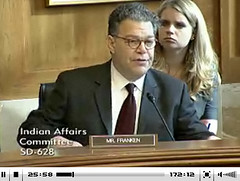
Senator Franken called the hearing to order, he was visibly exhausted from a voting session that lasted until 3 AM the
night before. He spoke for a few minutes until Chairman
Dorgan arrived. On behalf of the tribes in Minnesota, Franken thanked Dorgan for his leadership in getting The Indian Healthcare Improvement Act included the Health Reform Law. Senator Franken explained that he and Dorgan would only be able to stay a short time since another vote was due to start soon.
The last hearing regarding this issue was February 26, 2009.
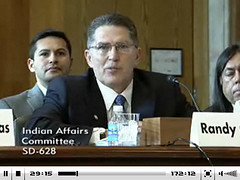 Randy Grinnell, Deputy Director of the Indian Health Service was the next testimony. He gave some requisite statistics regarding the IHS and youth suicide.
Randy Grinnell, Deputy Director of the Indian Health Service was the next testimony. He gave some requisite statistics regarding the IHS and youth suicide.
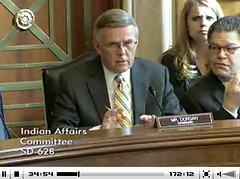
Chairman Dorgan arrived and thanked Grinnell for his testimony. Dorgan explained that he would have to leave soon and that he and Senator Franken had read the prepared testimony of each participant. It’s too bad they had to leave early because important testimony was given after they left.
Coloradas Mangas a sophomore at Ruidoso High School, Mescalero Apache Reservation, New Mexico read his poignant statement of personal numerous losses among his friends.
When I look at the resources that our neighbors have in the town of Ruidoso, I can’t help but notice how limited our I.H.S. hospital is when it comes to basic care and more importantly, mental health services. We have a mental health clinic, with only one full time psychologist. One psychologist to serve a community of 4,500 children, youth and adults. It is my understanding that she is currently on administrative leave – indefinitely. With her gone, we have a huge gap in the continuity of care.
What troubles me is that law enforcement and the court have a larger role to play during an attempt or completed suicide compared to our mental health clinic. Most attempters don’t seek help and some are court ordered to attend therapy. This role of the courts and law enforcement criminalizes their behavior and makes their recovery seem less important.
I applaud our community though. The tribal administration finally understands that our community-based services are not connecting in a vital way to meet the challenges of children and youth with serious mental health needs and their families. With this said, our tribe has applied for the SAMHSA Systems of Care grant. It is my hope that we can fundamentally change the way our services are delivered. Due to the most recent rash of suicides, a new program started in the community called the Honor Your Life Program. It is a SAMHSA funded program that is designed to implement and evaluate a comprehensive early intervention and suicide prevention model.
[snip]
We desperately need a shelter for the youth if they need a place to stay at certain times when the home life becomes very toxic. We have heard from other youth that if they just had a place to go for the night, that they would not have made an attempt on their life.
Dr. Paula Clayton, Medical Director, American FoundatIon for Suicide Prevention, New York City, New York was up next. She also talked about statistics and causes, her conclusion was that it was all about mental illness and screening for these illnesses among our nation’s youth.
Culturally sensitive but sustained efforts with multiple approaches offer our best hope to get students into treatments. Obviously, if there is a shortage of treatment resources, than dollars need to be allocated to develop innovative new treatments for Native American youths. We must reduce this fatal outcome. The American Foundation for Suicide Prevention is ready and willing to offer our expertise and advice to this Committee and to all members of Congress as you make the important decisions on how to reduce suicide in the Indian nations.
Ms. Laurie Flynn, Executive Director, TeenScreen National Center for Mental Health Checkups at Columbia University, New York, New York:
Recommendation – Expand Telemedicine with focus on mental health of youth
Identifying youth in need of mental health services through screening is of little utility if
we are unable to connect them to necessary services. As we referenced earlier, the IHS
suffers from a provider shortage for all types of providers, and child and adolescent
psychiatrists are in short supply, not just in the IHS, but the system more generally.
Furthermore, the rural and often isolated locations in which many American Indian and
Alaska Native youth reside contribute to the difficulty of connecting them to appropriate
mental health providers.
An important solution to addressing these challenges has been the expansion of the use of
telemedicine services, including telepsychiatry. For example, the University of New
Mexico’s Center on Rural Mental Health has been providing telepsychiatry services, also
referred to as tele-behavioral health services, to the Mescalero tribe and others in New
Mexico. Through a contract with the IHS and the State of New Mexico, the Center is able
to offer patient diagnosis, treatment, and supervision services. The Center is also able to
help address the workforce shortage by providing additional training and supervision to
mental health providers, such as social workers.
The success of such programs has spurred an increased investment in tele-behavioral
health services. The Methamphetamine and Suicide Prevention Initiative (MSPI)
included funding to establish a National Tele-Behavioral Health Center of Excellence,
and at least 50 IHS and federal sites are using or in the process of creating tele-behavioral
health services. The American Recovery and Reinvestment Act of 2009 (ARRA) also
provided funding to expand the infrastructure necessary to support telemedicine.
The health care reform legislation signed into law earlier this week also includes
provisions that will help expand access to services for American Indian and Alaska
Native youth. New grant moneys for telepsychiatry projects are included in the
legislation, as well as provisions targeted toward addressing IHS workforce recruitment;
improving rural health services; reducing health disparities; and expanding access to
preventive services.
These are all steps in the right direction, but we remain far from being able to serve all
youth who are in need of mental health services adequately. We must continue to address
the shortage of services through common-sense, proven approaches such as telemedicine.
In my opinion, the most compelling testimony came next. Mr. Hunter Genia, Behavioral Health Administrator, Saginaw Chippewa Indian Tribe, Mt Pleasant, Michigan provided what I considered to be the best recommendations for the committee and for tribal governments. His prepared statement did not include all of his actual testimony so Oke transcribed it for me. I must post most of it because it is worth the read. Mr. Genia works at the tribal level of government. Mr. Genia’s testimony begins at 64:24 into the webcast. The two previous speakers definitely had a non Indian perspective. I felt that Hunter really pin pointed what is causing the trouble in Indian Country.
[emphasis mine]
I also work for a coalition of tribes in Michigan that are recipients of a SAMHSA grant called “Access to Recovery.” I believe that was originally started under the Bush Administration and hopefully is continued under the Obama Administration, I’ll talk about that briefly as well. I also recognize where I come from, the Ottawa and Ojibwa Nation, that I descend from Pontiac, who in the 1700’s was the Great Lakes tribal leader who tried to thwart the expansion of western civilization because his fear was that we would adopt too many of the non-Native ways. We would lose ourselves and become lost.
I think what we are seeing in Indian Country is a deep psychological wound that has not healed for many, many generations and hundreds and hundreds of years. We have seen this in the Indian boarding schools that often go untalked about here in America, and in history books. We have not recovered here in Indian Country in full as a result.
People believe the Indian Boarding Schools were only from the 1870’s to the 1930’s. In Michigan we had one boarding school that remained open until the 1980’s. My own brother and my own sister attended these schools. You want to talk about trauma, it has only been disclosed in recent years that sexual abuse, physical abuse, emotional abuse, has occurred in these boarding schools, often led by a lot of the church institutions and missionaries.
But as Administrator I’ve been asked to try and address some of the lack of resources that we have regarding mental health services. So for the last four years I have been the Saginaw- Chippewa Behavioral Health Services Administrator, prior to that for six years our clinical mental health director. Prior to that for ten years I worked in the American Indian urban population where there is virtually zero dollars for Indian health care for a majority of Indian population that live in non-reservation communities.
The Saginaw-Chippewa Indian Tribe is providing nearly 70% of our funding just to operate our own programs, so the amount of dollars coming from Indian Health Services, and other grant funding, is much less than that, so I just want to point that out. Right now our tribe is putting over 1.5 million dollars into our mental health programs. We offer outpatient mental health, substance abuse, residential program, but we are very unique as a tribe. I want to point out that a majority of gaming tribes are not profitable. A majority of gaming tribes are in the red and cannot do what we are doing and providing, so in Michigan our tribe is very unique. One of the things I want to point out about the “Access To Recovery” grant is that it recognizes our cultural and spiritual beliefs, our teachings and our ceremonies; they are actually utilized in our efforts in recovery. Whether we’re working with adolescent children, adults, or our elders, the majority of our people are asking that traditional and cultural practices be a part of their treatment process. And that is one of the beautiful things about the Access to Recovery program under SAMSA; it actually acknowledges and respects who we are as an Indigenous people here in this country.
And I just want to point out and remind people that it wasn’t until 1978 that the American Indian Freedom of Religion Act was even passed, which took a special act by Congress. So until then many generations of our people had to live in hiding and privatize, really, who we are as an Indigenous people. And I just want to point that out because I think a lot of theses programs are great, but they are not really talking about where these wounds are originating. Many times what we have is a band-aid approach to addressing American Indian health needs, especially the mental health needs.
During the 2008, 2009 fiscal years, at any given time we had an average number of 60 tribal members waiting to access behavioral health services. During this time they would wait up to an average of three months before they could even see a counselor or clinician, and I just point that out because if we had more funding we could add more staff to our programs and our resources and be able to address some of those needs.
The Saginaw-Chippewa Indian Tribe also made a decision to build our own residential treatment facility. Before we even laid the first brick down to build this facility we had phone calls from all of the Michigan tribes asking if our facility would be open to their tribes, and unfortunately they’re not, and some of that has to do with the Indian Health Services policies regarding funding and some of the access to care. But one of the reasons we built the residential treatment facility on our own reservation is because other than our tribal residential program, our community members had to travel at least 6 to 8 hours or out of state to even access culturally sensitive approach to trauma in facilities and treatment programs. Otherwise they would go to non-native programs that often times were not sensitized to our values, our traditions, and our culture. Therefore a lot of the non-native institutions and approaches were utilized to treat our people and a lot of our people were discriminated against or bias in those treatment settings if they were non-native.
So I think since we opened up our own residential program over 250 of our own tribal members have gone through our residential program, and if that residential program was not there, probably the majority of them would have never even gone into treatment, at all. So, one of the things I want to point out is our tribe is footing the bill for most of our Indian health care, not the United States, or the Federal government, or the Indian Health Services for that matter. We are very fortunate that all the tribes in Michigan are part of the Access to Recovery grant, under SAMSA, but it still is not adequate funding to provide resources at the level we need in our tribal communities to provide services.
I am 40 yrs old; I got my Masters in Social Work from Grand Valley State University. I don’t drink, I don’t do drugs, and I don’t smoke. But I’m very much, in a non-conceited way, unique in that regard. I was talking to a young man here earlier before the meeting started that is from Pine Ridge, I think the difference is that someone along the way said I can be somebody, and I had an opportunity. We can call it mental health illness, but the fact is the majority of the Native American youth in this country doesn’t see the opportunity; they’re not given a chance to see what dreams they can aspire to.
If you look across the nation here, how many of our people do you see who are in politics? How many do you see in sports? How many do you see in entertainment? Virtually none, and until we are able to place our own people in places of leadership that our young people can turn on the radio and TV and see all they see its what’s in their own community, and they don’t understand that coming to Washington D.C. is a possibility for them. To be a Governor, to be a Senator, to be a Congressman. It’s very far and few in between.
I think what we’re trying to do and address in our community. I’ll give you two examples, last October we had G.O.N.A., Gathering of Native Americans, it was a four-day training actually facilitated by our own people actually initiated under SAMSA. And it brought all of our community together in a good way, in a good place to talk about what we needed to heal, as a community.
Because that is one thing we all have as universal truths in Indian country. There is a lot of walking wounded people in our community that have not healed from post traumatic historical trauma. Until we address some of those things and give it a name and acknowledge those then I’m not sure that all the programs in the world are going to help. We need to focus on healing and wellness in our tribal community and look at those kinds of things that are generated from multi-generational traumas.
The other thing that happened in our community, with the assistance of White Bison, that we had a journey for forgiveness hosted in our community. That for the first time in a Mt. Pleasant community addressed the impact Indian Boarding schools had on our people. As you know, Indian Boarding schools were very good at taking away our language, our cultures, and our traditions. Basically their goal was to Americanize us. So I think a lot of what’s happening is a big “who am I”?, “Where do I belong?”, “How do I fit in?”, ” Are we invited to the table?”, ” Are we important?”, I think a lot of our young people don’t feel that.
So a lot of things we’re trying to do in our community is to let them know that they are important and to help setup programs like that.
But I will say that a majority, 60 to 70 percent of our behavior health funding is because our tribe made it a priority, the Saginaw-Chippewa tribe. If we were to rely on the Indian Health Services funding or the Federal government we would not have a majority of the programs available to our own community. So we need more funding, we need more resources. We need more American Indian, Native American leaders, to step up and be a part of our tribal communities and lead these efforts and be seen and be visible in this country, in our communities.
I’ve had a couple of email exchanges with Hunter and he has more to say:
My understanding why this hearing was scheduled was due to a lot of factors. It appears on the surface that under the Obama administration Native American issues in general have become more discussable along with some movement towards increasing dollars for Indian Health care in general. Suicide in our Native American population has been coming to light more in the just the last few recent years; I think what bothers me is that it has been an ongoing issue though in Indian Country for some time. As we know it seems like we have to have a shooting or massacre to occur before attention is drawn to some of the health issues and disparities in Indian Country, otherwise no one really cares it seems. It is sad though that so many of our people have died at such a young age that we are an elder at 40 and if we made it to age 50, we’ve managed to do some thing right. We should expand the definition of suicide in my opinion to include the slow drowning of ourselves via alcohol, pain meds, and drugs, these modalities of feeling better are not the answer.
When I testified at the Senate Committee about the walking wounded, lets be real its 2010 and we are just now getting at the table to address health disparities and issues after how many centuries. Our region of Indian Health Services is the lowest funded health care region in the United States but overall it’s terrible and unthinkable but we are allowing it to happen in our original homeland. I give Obama credit for putting up the dollars to try and address this however it is going to take more than that. We can’t throw money at the problem and expect a cure or miracles we need to combine people, programs, and healing in combination and working with one another. It needs to be a multi faceted approach to start to put a small dent into the problem. The people that need to help are in the communities but they need to be empowered and the red tape or bureaucracy surrounding who qualifies to be a helper needs to be decided at the local level. Having said that, the local tribal communities need to avoid the crab in the bucket issues and focus on the healing and future generations in order to avoid or manage through.
What has happened in our community is that some of our people have become easy targets by tribal and non-tribal citizens due to gaming revenues that tribal members receive. We’ve had tribal community members become victimized by people who are like professionals at it from outside the local community. We have to be very careful because our population is at an increased risk for vulnerability and we haven’t been at the table long on how to deal and address some of these problems, mostly education and prevention are going to be the key and being creative, empowering, and community based focus probably are the best solutions and that is what we are trying to do here.
I love our people very much and we are a proud nation of people who have survived so much abuse in every sense of the word. We can do this, we can get better and it just saddens me when I know there are people hurting and the courage to ask for help and desire change within ourselves seems to be the biggest hurdle. We can do better and we will but its not going to happen overnight. One person at a time, one community at a time, it starts with us.
Hunter Genia
Hunter also pointed out in the open discussion that:
-half of the native population is under age 18.
-U.S. Education standards need to be addressed, many graduates don’t know what they should know about Indians. We will remain an invisible people as a result.
-Indian culture and tradition needs to be tied into Indian Country’s health care.
The final speaker was Novalene Goklish, Senior Research Coordinator, Celebrating Life Youth Suicide Prevention Program, White Mountain Apache Tribe/Johns Hopkins Center for American Indian Health, Celebrating Life/ Johns Hopkins Project, Whiteriver, Arizona:
Native American communities have tremendous resiliency. We have survived untold adversity by blending our traditional wisdom with new technologies. Culturally appropriate research is a great example. We must harness the power of traditional understanding and rigorous scientific research to stop youth suicide. Tribal university partnerships that are built on trust and longterm commitment-such as the White Mountain Apache Tribe and Johns Hopkins–are the most powerful means for achieving renewed health. Federal funds are well spent in the arena of suicide prevention to reduce the high toll of medical costs and human suffering and to ensure our most precious asset-our youth-live to full maturity and potential. In our belief system, every human life serves a purpose to maintain the health and well-being of Mother Earth. We must find the means to re-learn as a human race that life is sacred; that life is precious; that life is meant to be lived out serving our greater common purpose.
I was unable to find out how long this hearing had been scheduled. Many believe it was a result of the Facebook Call the Whitehouse campaign. I do agree with Hunter Genia that many things that are happening now for Indian Country are because Obama is in office. I think it’s really too bad that Senators Dorgan and Franken missed Hunter Genia’s testimony. I hope that publishing his words here will help more people to see how this issue needs to be addressed.
Cross Posted at Native American Netroots
An ongoing series sponsored by the Native American Netroots team focusing on the current issues faced by American Indian Tribes and current solutions to those issues.
![]()
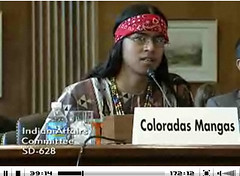
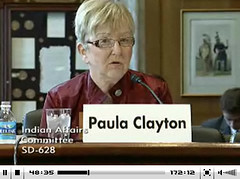
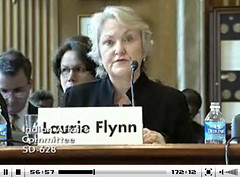
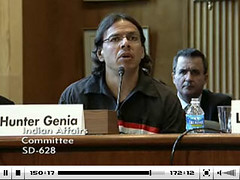
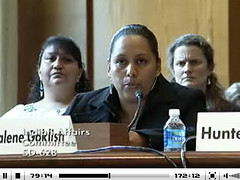
Leave a Reply